
Dark-eyed junco, Junco hyemalis.
Click image for a larger view in its own window.
Photo by Dawn Bailey and appears here by permission.
Birds in Science
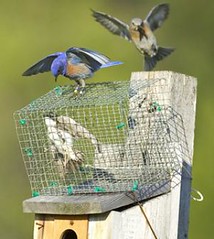 A Duke University evolutionary ecologist reported evidence that aggressive male western bluebirds, Sialia mexicana, out-compete less aggressive males for preferred breeding territories, a finding that may offer more insight into how evolution operates. This research, conducted by Renée Duckworth suggests the birds may play more active roles in their own natural selection than traditional models of evolution would support. Further, it was also shown in this report that more aggressive and milder mannered birds also tended to breed in different settings that favor different body types. To study this, Duckworth created a breeding ground by setting out nest boxes to attract the birds on a ranch in Montana. She purposely manipulated the densities of the nest boxes, putting two rather than one in some territories to test whether more-aggressive males were better at acquiring territories with multiple nests. Duckworth measured each male's aggressiveness by observing its response to a tree swallow that she placed near a nest box (pictured). Tree swallows, Tachycineta bicolor, are a rival species known to compete with bluebirds for nesting spaces in the wilds. "Taken together, these experiments show that, first, aggression plays a key role in determining the outcome of territorial interactions, and, second, male aggression is set before they ever get to their territories," Duckworth said. "These results support my previous findings that males are highly consistent in their aggressive behavior and can be categorized as either aggressive or nonaggressive." This study was published online on12 April 2006, in the peer-reviewed journal, Proceedings of the Royal Society B. [PDF].
A Duke University evolutionary ecologist reported evidence that aggressive male western bluebirds, Sialia mexicana, out-compete less aggressive males for preferred breeding territories, a finding that may offer more insight into how evolution operates. This research, conducted by Renée Duckworth suggests the birds may play more active roles in their own natural selection than traditional models of evolution would support. Further, it was also shown in this report that more aggressive and milder mannered birds also tended to breed in different settings that favor different body types. To study this, Duckworth created a breeding ground by setting out nest boxes to attract the birds on a ranch in Montana. She purposely manipulated the densities of the nest boxes, putting two rather than one in some territories to test whether more-aggressive males were better at acquiring territories with multiple nests. Duckworth measured each male's aggressiveness by observing its response to a tree swallow that she placed near a nest box (pictured). Tree swallows, Tachycineta bicolor, are a rival species known to compete with bluebirds for nesting spaces in the wilds. "Taken together, these experiments show that, first, aggression plays a key role in determining the outcome of territorial interactions, and, second, male aggression is set before they ever get to their territories," Duckworth said. "These results support my previous findings that males are highly consistent in their aggressive behavior and can be categorized as either aggressive or nonaggressive." This study was published online on12 April 2006, in the peer-reviewed journal, Proceedings of the Royal Society B. [PDF].
In a series of unique experiments, zoologists Graham Taylor and Adrian Thomas at Oxford University in the UK have equipped a tame Steppe Eagle, Aquila nipalensis, with miniature spy cameras and other instruments to precisely record its movements during flight. These studies have already provided new insight into the way birds control themselves in flight. "The results so far show that head movement is very important to flight," Taylor said. "As the bird banks into a turn it constantly flicks its head into the turn. The idea I'm working on at the moment is that the bird looks in the direction it wants to turn and the body catches up." These results could provide greater understanding for how we can improve aircraft. (Research video [mov] and video of the handler gliding the research subject, with her eagle, named Cossack).
Droppings from seabirds could be introducing radioactive isotopes into the food chain. This is the conclusion of researchers who found high levels of radioactivity in droppings and plants on an island close to the Arctic. The evidence that bird droppings are bringing radioactivity ashore comes from Mark Dowdall and his team at the Norwegian Radiation Protection Authority in Tromsø. They spent two years between 2000 and 2002 collecting soil, vegetation and guano samples from a remote coastal inlet called Kongsfjord on the Arctic archipelago of Svalbard, about halfway between the northern tip of Norway and the North Pole. Dowdall believes the birds eat contaminated fish and crustaceans, and the radioactive material is then concentrated in their feces. The extra nutrients the droppings provide encourage plants to grow, and the plants take up and concentrate the radioactive material. This poses a problem, because plants make up the bulk of the diet of many animals, especially that of indigenous reindeer. "We're talking about a very vulnerable environment, and when reindeer eat the [contaminated] vegetation, it's in the food chain," says Dowdall. GrrlScientist comment: Guess who eats caribou and drinks their milk and wears their skins?
People Helping Birds
A bald eagle chick hatched unaided on Santa Cruz Island, the largest of the eight Channel Islands off the coast of Southern California. The event marks the first time in 50 years that threatened bald eagles, Haliaeetus leucocephalus, have successfully reproduced on the islands, because they have suffered from the damaging effects of chemical contamination from decades earlier. "The success of this nest brings hope that we will reestablish bald eagles on the Channel Islands," Russell Galipeau, superintendent of Channel Islands National Park, said in a press release. "All Americans can share in the excitement of this historic event." The last time a bald eagle was hatched on the Northern Channel Islands was in 1949 on Anacapa Island. Due to the millions of pounds of chemicals that were released into the ocean off the Palos Verdes Peninsula in Los Angeles County between 1940 and 1970, the bald eagles have produced eggs with dangerously thin shells that weren't strong enough for incubation.
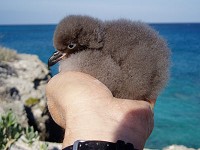 Great news! The future for Bermuda's national bird the Bermuda petrel or Cahow, Pterodroma cahow (pictured), has never been brighter after 36 chicks hatched at Nonsuch Island. The bird, which has become a powerful symbol of hope, was thought extinct for over 500 years. Its rediscovery in 1951 sparked a long-running conservation project to restore the species. Jeremy Madeiros, Government conservation officer, said there were now 75 nesting pairs at the island -- more than ever before.
Great news! The future for Bermuda's national bird the Bermuda petrel or Cahow, Pterodroma cahow (pictured), has never been brighter after 36 chicks hatched at Nonsuch Island. The bird, which has become a powerful symbol of hope, was thought extinct for over 500 years. Its rediscovery in 1951 sparked a long-running conservation project to restore the species. Jeremy Madeiros, Government conservation officer, said there were now 75 nesting pairs at the island -- more than ever before.
 Efforts are underway to restore the native bobwhite quail, Colinus virginianus (pictured), in Arkansas. In the past half-century, quail hunting in Arkansas has plummeted from first to near last in popularity among the state's outdoors people. Quail were already on the decline in the 1950s as farming practices and land use changed. "Clean" farming, meaning cultivation of every bit of available cropland, took out the fence rows and marginal strips that were quail homes. Woodlots were cleared, burned and planted in soybeans. Several other issues include the presence of coyotes and the increased used of agriculture chemicals, especially pesticides and herbicides. GrrlScientist note: It's too bad the birds aren't being restored for the sake of preserving them. The fact is, these birds are being restored so people can go out and shoot them.
Efforts are underway to restore the native bobwhite quail, Colinus virginianus (pictured), in Arkansas. In the past half-century, quail hunting in Arkansas has plummeted from first to near last in popularity among the state's outdoors people. Quail were already on the decline in the 1950s as farming practices and land use changed. "Clean" farming, meaning cultivation of every bit of available cropland, took out the fence rows and marginal strips that were quail homes. Woodlots were cleared, burned and planted in soybeans. Several other issues include the presence of coyotes and the increased used of agriculture chemicals, especially pesticides and herbicides. GrrlScientist note: It's too bad the birds aren't being restored for the sake of preserving them. The fact is, these birds are being restored so people can go out and shoot them.
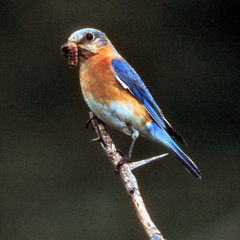 Oregon bird lovers report that the population of western bluebirds, Sialia mexicana, is increasing. The songbirds' numbers diminished in the 20th century as a result of increased development of their homes into farmland and cities. Invasive species, such as European starlings, also did damage. "Back in the 1900s, they [bluebirds] were quite common," said Pat Gallagher, bluebird project manager for the Salem Audubon Society. "But then, people started clearing land for farming and cutting down trees and introducing the house sparrow and starling." Eastern bluebirds, Sialia sialis (pictured), for example, declined by 90 percent, Gallagher said.
Oregon bird lovers report that the population of western bluebirds, Sialia mexicana, is increasing. The songbirds' numbers diminished in the 20th century as a result of increased development of their homes into farmland and cities. Invasive species, such as European starlings, also did damage. "Back in the 1900s, they [bluebirds] were quite common," said Pat Gallagher, bluebird project manager for the Salem Audubon Society. "But then, people started clearing land for farming and cutting down trees and introducing the house sparrow and starling." Eastern bluebirds, Sialia sialis (pictured), for example, declined by 90 percent, Gallagher said.
Efforts to re-establish endangered trumpeter swans, Cygnus buccinator, in Wisconsin have resulted in a flock that this summer is expected to number more than 500 swans, according to the state's Department of Natural Resources Bureau of Endangered Resources. Trumpeter swans, named for their resonant, trumpeting call, are the largest waterfowl species in North America. "We had 92 nesting pairs last year and we expect that number to increase this summer as more birds reach sexual maturity," says Sumner Matteson, an avian ecologist with the bureau. An ongoing threat to native trumpeter swans expanding their range in the state is the expansion of a separate population of non-native mute swans, Cygnus olor. The mute swan is a Eurasian bird first introduced by immigrants, but their population is increasing from escaped or accidentally released captive birds. Mute swans are more aggressive than trumpeter swans and out-compete them for valuable resources, sometimes even killing them.
Parrots in the News
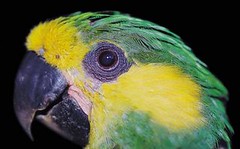 With the slogan, Si vuelan las Palmas, palman los loros! ("If the palms fly away, the parrots will too!"), a national campaign was launched in Ecuador on 30 March for the conservation of the Wax Palm, the Yellow-eared Parrot, Ognorhynchus icterotis (pictured), and the Golden-plumed Parakeet, Leptosittaca branickii. The campaign is being organized by Aves & Conservación (BirdLife in Ecuador) and the Jocotoco Foundation, and has received official support from the Ecuador Ministry of Environment. The main threat for these two parrot species is the disappearance of the wax palm which is being exploited in an unsustainable fashion each year for the celebration of Palm Sunday. Thousands of wax palms are "harvested" every year to fulfill the demand for palms at this Easter Catholic celebration (the great majority of Ecuadorians are Catholics and very attached to such traditions). The extraction of the central leaves of the palm prevents its development and often causes the death of the specimen. Wax palms need around 25-30 years to reach their reproductive stage and more than 75-100 years to die off naturally and become suitable places in which the parrots can rest and build nests. GrrlScientist wonders; Am I the only one who remembers writing about this very same story last year??
With the slogan, Si vuelan las Palmas, palman los loros! ("If the palms fly away, the parrots will too!"), a national campaign was launched in Ecuador on 30 March for the conservation of the Wax Palm, the Yellow-eared Parrot, Ognorhynchus icterotis (pictured), and the Golden-plumed Parakeet, Leptosittaca branickii. The campaign is being organized by Aves & Conservación (BirdLife in Ecuador) and the Jocotoco Foundation, and has received official support from the Ecuador Ministry of Environment. The main threat for these two parrot species is the disappearance of the wax palm which is being exploited in an unsustainable fashion each year for the celebration of Palm Sunday. Thousands of wax palms are "harvested" every year to fulfill the demand for palms at this Easter Catholic celebration (the great majority of Ecuadorians are Catholics and very attached to such traditions). The extraction of the central leaves of the palm prevents its development and often causes the death of the specimen. Wax palms need around 25-30 years to reach their reproductive stage and more than 75-100 years to die off naturally and become suitable places in which the parrots can rest and build nests. GrrlScientist wonders; Am I the only one who remembers writing about this very same story last year??
A newly hatched Spix's macaw, Cyanopsitta spixii, was the best easter gift one could receive since it was the offspring of the world's rarest parrot species, which has been extinct in the wild since October 2000 in its home country of Brazil. This species is so rare that it will only be saved by means of a captive breeding program and this chick comes from the only active breeding pair at present found in a zoological garden. The chances for optimal development of this nestling are good and the Loro Parque Fundación is optimistic that this Spix's Macaw will grow to be an adult and contribute to the conservation of its species. Sadly, there are less than 100 Spix's Macaws alive today.
Avian Influenza News
"One migratory bird does not a pandemic make," said Dr. Anthony Fauci, the National Institutes of Health's infectious disease chief, adding that U.S. poultry farmers -- like their colleagues in Europe -- should keep their flocks isolated from contact with wild birds. Most people in the United States have limited contact with poultry or their droppings that would contain high levels of virus if the birds were infected. "The surveillance is going to be so intense that it is very unlikely that there is going to be the type of situation we see everywhere from Nigeria to Indonesia," observed Fauci. The public should worry only if bird flu shows signs of human to human transmission. In that case, airline passengers arriving from an afflicted area would pose a greater threat than any chicken, Fauci said.
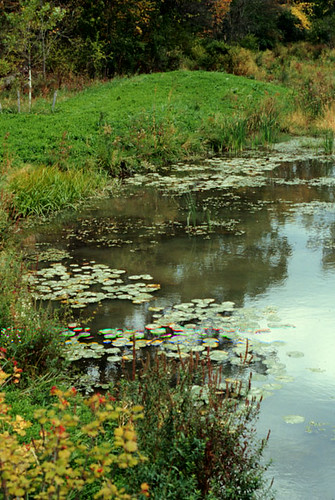 Restoring wetlands and moving poultry farms away from migratory flyways could help curb the spread of bird flu by stopping wild birds from mixing with domestic fowl, a UN-commissioned report said this past Tuesday. "There's a contraction for the habitat for wild birds and a natural situation arising which promotes the inter-mixing of wild birds and domestic poultry," said David Rapport, a Canadian professor and lead author of the report. Wild birds are believed to have played an as-yet undetermined a role in the spread of the H5N1 virus into more than 45 countries. [Photo: Department of Natural Resources, Cornell].
Restoring wetlands and moving poultry farms away from migratory flyways could help curb the spread of bird flu by stopping wild birds from mixing with domestic fowl, a UN-commissioned report said this past Tuesday. "There's a contraction for the habitat for wild birds and a natural situation arising which promotes the inter-mixing of wild birds and domestic poultry," said David Rapport, a Canadian professor and lead author of the report. Wild birds are believed to have played an as-yet undetermined a role in the spread of the H5N1 virus into more than 45 countries. [Photo: Department of Natural Resources, Cornell].
There is increasing evidence, experts say, that a thriving international trade in smuggled poultry products -- including live birds and their chicks, eggs, meat, feathers and other products -- is making a substantial contribution to the spread of the H5N1 bird flu virus. Poultry smuggling is a huge and previously largely overlooked business, perhaps second only to narcotics in international contraband, experts and government officials believe. H5N1 is a robust virus that survives not just in live birds but in frozen meat, feathers, bones and on used cages -- although it dies with cooking. "No one knows the real numbers, but they are large; behind illegal drug traffic, illegal animals are No. 2," said Timothy Moore, an official at the University of Nebraska who has advised the U.S. government on agricultural disaster planning. "And there is no doubt in my mind that this will play a prominent role in the spread of this disease. It looks to be the main way it is spreading in some parts of the world." GrrlScientist notes: "Bird flu" has been documented to be spread primarily by the POULTRY industry, and according to my sources, this spread is through legal movement of birds to market and from one farm to another, as well as movements of their fertile eggs.
 A dead swan found in the United Kingdom that tested positive for the deadly H5N1 strain of bird flu was a whooping swan, Cygnus cygnus (pictured), DNA tests revealed. Whitehall (UK) sources said that a "working hypothesis" is the bird could have died in another country and washed up on the Scottish coast. "The likeliest scenario - and this has to be in the realms of speculation - is that this bird may have set off on its journey northwards, got part of the way across the North Sea, felt grotty, and landed on or fell into the sea, died and was washed into Cellardyke," said the RSPB spokesman Andre Farrar. The fact that this bird could only be identified by DNA fingerprinting illustrates our need for better quality data collection, which is crucial for designing better contingency plans, for predicting future outbreaks, and for guiding effective policy to reduce the economic and conservation impacts of avian influenza.
A dead swan found in the United Kingdom that tested positive for the deadly H5N1 strain of bird flu was a whooping swan, Cygnus cygnus (pictured), DNA tests revealed. Whitehall (UK) sources said that a "working hypothesis" is the bird could have died in another country and washed up on the Scottish coast. "The likeliest scenario - and this has to be in the realms of speculation - is that this bird may have set off on its journey northwards, got part of the way across the North Sea, felt grotty, and landed on or fell into the sea, died and was washed into Cellardyke," said the RSPB spokesman Andre Farrar. The fact that this bird could only be identified by DNA fingerprinting illustrates our need for better quality data collection, which is crucial for designing better contingency plans, for predicting future outbreaks, and for guiding effective policy to reduce the economic and conservation impacts of avian influenza.
Bird flu has the poultry industry around the world on alert, and provokes health fears over a human strain of the virus. But what does it mean for the UK's backyard (garden) birds? Certainly, the arrival of H5N1 in the wild bird population is a threat, not least because infection could kill or further imperil rare and endangered species. The Royal Society for the Protection of Birds (RSPB), British Trust for Ornithology (BTO) and Wildfowl & Wetlands Trust have come together to stress that it should be business as usual for feeding garden birds. Culling a flock can be the appropriate response in poultry, he says, but the World Health Organization, the UN and governments agree it is not the same for wild birds. "[A cull of wild birds] could only make the situation worse by causing the birds to escape, and disperse. You then put birds of conservation significance into direct peril."
Streaming Birds
 This week on BirdNote, you will learn more about; Birdathon 2006 -- join your local Audubon chapter's Birdathon now!; Tuesday, American Kestrel, Falco sparverius; Wednesday, the Grays Harbor (Washington) Shorebird Festival, April 28-30, which includes a link to their web site; Thursday, the Marsh Wren, Cistothorus palustris; and Friday, celebrating Earth Day 2006. BirdNotes transport the listener out of the daily grind with two-minute vignettes that incorporate the rich sounds of birds provided by Cornell University and by other sound recordists, with photographs and written stories that illustrate the interesting -- and in some cases, truly amazing -- abilities of birds. Some of the shows are Pacific Northwest-oriented, but many are of general interest. BirdNote can be heard live, Monday through Friday, 8:58-9:00AM in Western Washington state and Southern British Columbia, Canada, on KPLU radio and now also in North Central Washington state on KOHO radio. All episodes are available in the BirdNote archives, both in written transcript and mp3 formats, along with photographs. Listener ideas and comments are welcomed. [rss mp3/podcast].
This week on BirdNote, you will learn more about; Birdathon 2006 -- join your local Audubon chapter's Birdathon now!; Tuesday, American Kestrel, Falco sparverius; Wednesday, the Grays Harbor (Washington) Shorebird Festival, April 28-30, which includes a link to their web site; Thursday, the Marsh Wren, Cistothorus palustris; and Friday, celebrating Earth Day 2006. BirdNotes transport the listener out of the daily grind with two-minute vignettes that incorporate the rich sounds of birds provided by Cornell University and by other sound recordists, with photographs and written stories that illustrate the interesting -- and in some cases, truly amazing -- abilities of birds. Some of the shows are Pacific Northwest-oriented, but many are of general interest. BirdNote can be heard live, Monday through Friday, 8:58-9:00AM in Western Washington state and Southern British Columbia, Canada, on KPLU radio and now also in North Central Washington state on KOHO radio. All episodes are available in the BirdNote archives, both in written transcript and mp3 formats, along with photographs. Listener ideas and comments are welcomed. [rss mp3/podcast].
BirdCams
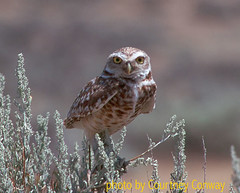 There are burrowing owls, Athene cunicularia (pictured), nesting in Washington state, and the Washington Department of Fish and Wildlife has streaming footage of one such nest from last year that successfully raised 12 owlets to independence. Video available in either Windows Media Player or Real Video Player formats.
There are burrowing owls, Athene cunicularia (pictured), nesting in Washington state, and the Washington Department of Fish and Wildlife has streaming footage of one such nest from last year that successfully raised 12 owlets to independence. Video available in either Windows Media Player or Real Video Player formats.
During spring 2004, the Washington Department of Fish & Wildlife installed a camera at a ferruginous hawk, Buteo regalis, nest site in central Washington. This linked site is packed with information about these rare hawks and includes photos and video clips from 2005. Last year's chicks hatched on 25 & 26 June, 2005 and the nest is active now, so you have a chance to follow these rare raptors throughout their breeding season!
You can watch nesting peregrine falcons live on the River Watch Falcon Cam. The good news is that these birds should begin laying their eggs very soon; the date that the first egg appeared in the past ranges from 14-22 April.
Miscellaneous Birds
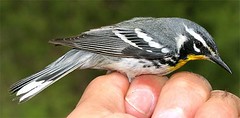 Although Yellow-throated Warblers, Dendroica dominica (pictured), breed commonly in the southeastern quadrant of the US, they are seldom captured at Hilton Pond Center in South Carolina -- mostly because they frequent only the highest forest canopy. The naturalists at This Week at Hilton Pond managed to band one of these elusive warblers, even though they caught the bird in an unexpected way. To view the story of this unusual encounter, please visit their photo essay. As always, they include a tally of birds banded and recaptured, along with miscellaneous nature notes.
Although Yellow-throated Warblers, Dendroica dominica (pictured), breed commonly in the southeastern quadrant of the US, they are seldom captured at Hilton Pond Center in South Carolina -- mostly because they frequent only the highest forest canopy. The naturalists at This Week at Hilton Pond managed to band one of these elusive warblers, even though they caught the bird in an unexpected way. To view the story of this unusual encounter, please visit their photo essay. As always, they include a tally of birds banded and recaptured, along with miscellaneous nature notes.
Speaking of great bird photos, here is a link to a stunning sequence of photos of a female Anna's hummingbird, Calypte anna, that nested outside a little boy's bedroom window in Seattle in early February-early April, 2006. This site also includes links to streaming videos of this bird.
A 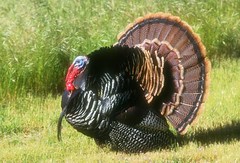 wild turkey, Meleagris gallopavo (pictured), shattered a window at the St. Joseph County Library, in Indiana, toppling rows of books, until a custodian captured the disoriented bird. "I've heard of deer going through houses, but never turkeys going into a library," library branch manager Judy Falzon said after Friday's excitement at the branch on South Bend's west side.
wild turkey, Meleagris gallopavo (pictured), shattered a window at the St. Joseph County Library, in Indiana, toppling rows of books, until a custodian captured the disoriented bird. "I've heard of deer going through houses, but never turkeys going into a library," library branch manager Judy Falzon said after Friday's excitement at the branch on South Bend's west side.
Turkeys sure do love public attention. In this story, NYC Parks & Recreation Commissioner, Adrian Benepe, joined representatives from Animal Care & Control and the NYPD Emergency Service Unit to release Hedda Gobbler, a wild turkey, into Morningside Park in northern Manhattan. Hedda Gobbler is named after Henrik Ibsen's character, Hedda Gabler. Hedda craved her freedom and was committed to social conventions. Likewise, our "fowl" friend is also highly social and independence oriented. By inhabiting Morningside Park, Hedda Gobbler will be listed with Zelda, who resides in Battery Park in midtown Manhattan, as famous New York City turkeys. GrrlScientist notes: I can think of other famous NYC turkeys, although none of them wear feathers.
North Dakota has played host to at least eight "accidental" migratory bird species so far this spring. The bird causing the most chirps is a mountain plover, Charadrius montanus, that Dr. Alan Van Norman, of Bismarck, saw and photographed about five miles northeast of Marmarth on Sunday morning as he was watching and filming sage grouse on their leks. Four other infrequent visitors to North Dakota were spotted over the weekend, and birders saw three others the previous week. The sightings of eight accidentals in two weeks is far more than usual. "Typically, maybe one or two a month over a year. To see eight in two weeks is pretty unusual," said Corey Ellingson, president of the Bismarck-Mandan Bird Club and the reporter for the North Dakota Birding Society.
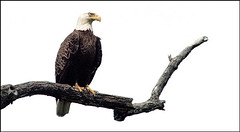 In other eagle news, George the bald eagle, apparently intimidated by a female eagle that seriously injured his mate and the mother of his clutch, Martha (pictured), is neglecting the nest to take up with the interloper, an environmental official said Monday. "This morning, we stopped seeing signs of incubator feeding," said Stephanie Spears, senior environmental specialist for the Woodrow Wilson Bridge Project on the Capital Beltway around Washington, D.C. "We saw him flying around with the other bird. He's starting to bond with the new eagle."
In other eagle news, George the bald eagle, apparently intimidated by a female eagle that seriously injured his mate and the mother of his clutch, Martha (pictured), is neglecting the nest to take up with the interloper, an environmental official said Monday. "This morning, we stopped seeing signs of incubator feeding," said Stephanie Spears, senior environmental specialist for the Woodrow Wilson Bridge Project on the Capital Beltway around Washington, D.C. "We saw him flying around with the other bird. He's starting to bond with the new eagle."
Bird Activism
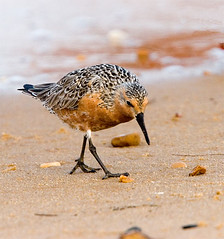 As you know, dear readers, the Red Knot, Calidris canutus (pictured), is facing a crisis. Populations of this shorebird have crashed in recent years and biologists estimate that the rufa subspecies could be extinct in as little as five years. The reason; overfishing of horseshoe crabs in Delaware Bay. The rufa Red Knot migrates from the tip of South America to Canada each spring to breed. Its one crucial stop is in Delaware Bay to refuel on horseshoe crab eggs. Without this food source, it cannot complete the journey. Declines in Red Knot and other shorebird numbers mirror declines in horseshoe crabs. Without a moratorium on the take of horseshoe crabs in Delaware Bay, the knot declines will continue towards extinction. You can participate in an email campaign to alert regulators that the moratorium must take place and that an alternative proposed by the horseshoe crab fishing industry of taking only male crabs will not be sufficient to stem the declines. TODAY (17 April) is your last day to comment. [Photo: DCWild.]
As you know, dear readers, the Red Knot, Calidris canutus (pictured), is facing a crisis. Populations of this shorebird have crashed in recent years and biologists estimate that the rufa subspecies could be extinct in as little as five years. The reason; overfishing of horseshoe crabs in Delaware Bay. The rufa Red Knot migrates from the tip of South America to Canada each spring to breed. Its one crucial stop is in Delaware Bay to refuel on horseshoe crab eggs. Without this food source, it cannot complete the journey. Declines in Red Knot and other shorebird numbers mirror declines in horseshoe crabs. Without a moratorium on the take of horseshoe crabs in Delaware Bay, the knot declines will continue towards extinction. You can participate in an email campaign to alert regulators that the moratorium must take place and that an alternative proposed by the horseshoe crab fishing industry of taking only male crabs will not be sufficient to stem the declines. TODAY (17 April) is your last day to comment. [Photo: DCWild.]
The Fine Print: Thanks to my bird pals; an anonymous reader, "Australian Bird", Joe, "justawriter", Mary, Sara, Ian, Mike, Gaylord, Dawn, Scott, Jeremy, Caren, Bill, Ellen and Ron for some of the news story links that you are enjoying here. Thanks to Pamela for her $upport and to Ian for catching that one teensy little error. All images that appear here are either linked from the news stories that they accompany or they are linked to the site where they are found. You can follow these links by clicking on individual images. The featured image appears here by permission.
Previous : : Birds in the News : : Next
tags: Birds in the News, ornithology, birds, avian, newsletter


Great images. Especially of the humming birds and the Steppe Eagle.
So nice to see Birds In The News again!
I know Renee from Duke, she is very smart!
G/S:
Thank you for resurrecting BITN, so appropriate following Easter. I can tell that much work and creative writing went into this issue. You have brightened my Monday morning immeasurably. Thanks so much for the excellent journalism and stunning pictures.
How wonderful to see the bobwhite quail. Before dense development moved into our area, the woods rang with their calls. I miss the sound very much.
Nice collection and pictures - I'm glad to see it back.
Interesting story about the Red Knot. I'm assuming that the bird's timing of migration coincides with the annual migration of horseshoe crabs onto the shore around Delaware to lay their eggs. Am I correct?
Another recommendation for your long book list - "The Birds of Heaven: Travels With Cranes" by Peter Matthiessen, one of my favorite writers in both fiction and nonfiction.
Excellent photos and stories as usual! Thanks for putting this together.
The video of the Steppe Eagle is amazing! I also appreciate the success stories, there is not much of that in the world today. I also love birdcams. Hoping to get my own photos of burrowing owls here in Idaho this year.
Thanks once again for a great week of reading!!
Great collection of stories. I absolutely love the hummingbird piece. Those are a fantastic series of photographs. Wow. What luck to have that nest to close.
Well, I was wondering when George would take up with the new eagle. If the nest is being neglected, do you think the eggs will be rescued and incubated somewhere else?
Follow-up to the turkey in Morningside Park - Manhattan's being invaded by the beasts - http://www.curbed.com/archives/2006/04/17/breaking_turkey_nabbed_like_h…
I thought some of you may enjoy this link to a pair of nesting eagles on Hornby Island in British Columbia. There are two eggs due to be hatched around the 26th of this month.
http://www.infotecbusinesssystems.com/wildlife/default.asp